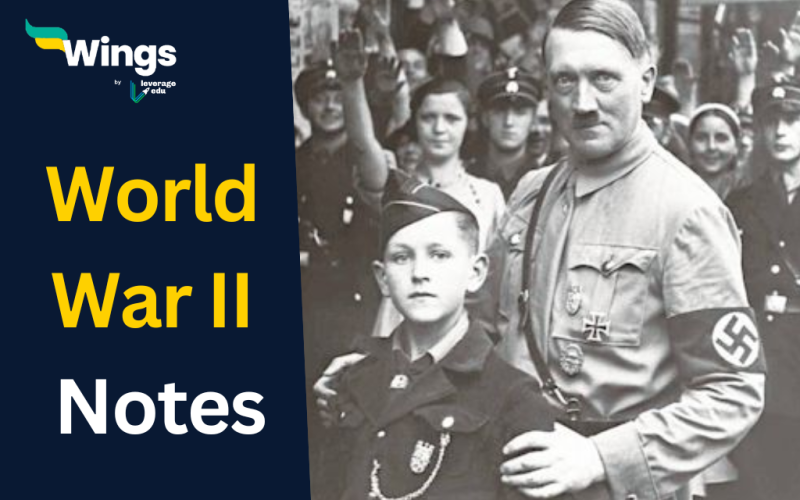Hey, Students! Please welcome Professor Owl 🦉. He will be telling us today about ‘World War 2’ Since owls are very wise, Hootfully, He’ll be of help to you! If you scroll further down this blog, you’ll see all the information you will need!
World War 2, also known as WW2 or the Second World War, was a significant event in human history that shaped the course of the 20th century. WW2 is an essential portion of the history syllabus for UPSC, Banking, Management and Defence exams. UPSC Preliminary and UPSC Mains Exams often contain questions related to World War 2. In this blog, we’ll provide you with a concise overview of this significant conflict, perfect for any competitive exam revision.
Table of Contents
⚔️ When was World War 2? Starting and Ending Dates
World War 2 began on September 1, 1939, when Nazi Germany, led by Adolf Hitler, invaded Poland. World War 2 ended on September 2, 1945, after the United States dropped atomic bombs on Hiroshima and Nagasaki, leading to Japan’s surrender.
📅 Important 2nd World War Dates
Following are some dates significant to the Second World War –
| December 7, 1941 | The attack on Pearl Harbour brought the United States into the war. |
| June 6, 1944 | D-Day, when the Allied forces launched a massive invasion of Normandy. |
| May 8, 1945 | Victory in Europe (VE) Day, marking the end of the war in Europe. |
Also Read: 🌏 World War 1: History and Causes | World History Notes
🤵 Who started World War 2?
Nazi Germany, under Adolf Hitler’s leadership, initiated World War 2 by invading Poland, violating international treaties.
Did You Know?: WW2 was the deadliest conflict in human history, with an estimated 70-85 million casualties.
🤺 What was World War 2 about?
The Second World War was fought by the Allied Powers vs The Axis Powers. World War 2 was primarily about territorial expansion, the quest for power, and ideological conflicts. Major factors included the aggressive expansionist policies of Nazi Germany, the desire to maintain global influence, and the struggle against fascism.
🗓️ Important WW2 Events
Some important WW2 Events are-
- The Holocaust: The systematic genocide of six million Jews by the Nazis.
- Battle of Stalingrad: A brutal turning point where Soviet forces defeated the Germans.
- Atomic bombings of Hiroshima and Nagasaki: The use of atomic weapons to force Japan’s surrender.
🚩 Who fought in WW2?
The Second World War was fought by the Allied Powers vs The Axis Powers.
The major Allied Powers: United States, United Kingdom, Soviet Union, China, and France.
The Axis Powers: Nazi Germany, Italy, and Japan.
Must Read: What Is Nationalism? Definition, History, and Significance
🌏 Global Impact of World War 2
The global impact of World War 2 was profound, leaving a lasting mark on the world. Here are some key pointers outlining its impact:
- Destruction and Loss of Life: WW2 resulted in widespread destruction of cities and infrastructure. It caused the loss of an estimated 70-85 million lives, making it the deadliest conflict in history.
- Redrawing of Borders: The war led to significant territorial changes, including the division and occupation of Germany and the realignment of European borders.
- Emergence of Superpowers: The United States and the Soviet Union emerged as superpowers, leading to the Cold War.
- Formation of the United Nations: The United Nations (UN) was established in 1945 to promote international cooperation and prevent future conflicts.
- Decolonization: WW2 contributed to the process of decolonization, as European colonial empires weakened.
- Technological Advancements: The war accelerated technological advancements, including the development of radar, jet engines, and the atomic bomb.
- Human Rights: The Holocaust, the systematic genocide of Jews and others, had a profound impact on collective memory and led to the recognition of human rights.
- Economic Changes: The global economy transformed significantly, with the United States becoming an economic powerhouse.
- New World Order: The establishment of international organizations and alliances, like NATO, shaped the post-war world order.
- Shift in Ideological Power: The defeat of fascist ideologies and the spread of democracy and liberal values became prominent after the war.
- Reconstruction Efforts: Extensive efforts were made to rebuild war-torn countries through the Marshall Plan and other aid programs.
- Social and Cultural Changes: The war had social and cultural impacts, including changes in gender roles.
- Technology Transfer: WW2 led to the transfer of technology and scientific knowledge between countries, contributing to the post-war technological boom.
- Legacy of the Cold War: The Cold War rivalry between the United States and the Soviet Union defined global politics for decades.
- Influence on Art and Literature: WW2 had a profound impact on art and literature, with works that reflected the trauma and experiences of the war.
“Kiddos, I’ve answered all your queries with the utmost precision that I was capable of. Now, I’ll be taking my leave, but if you think I might have missed something, do check out the FAQ section or drop a comment. I always respond!”
FAQs
World War 2 started when Nazi Germany invaded Poland, triggering a chain reaction of alliances and conflicts.
The consequences of WW2 include the redrawing of borders, the establishment of the United Nations, and the start of the Cold War.
World War 2 ended with the unconditional surrender of the Axis Powers, marked by the dropping of atomic bombs on Japan.
The Holocaust was a horrific genocide during WW2, where millions of Jews and other minorities were systematically killed by the Nazis.
World War 2 changed the world by redrawing maps, leading to the establishment of the United Nations, and shaping the post-war order.
RELATED BLOGS
In conclusion, World War 2 was a defining moment in history, characterized by immense destruction and suffering. Understanding its key dates, events, and consequences is essential for anyone studying this period in depth.
Hope you have gotten all the relevant information about ‘World War 2’! If you want to know more about topics like this, then visit our general knowledge page! Alternatively, you can also read our blog on general knowledge for competitive exams!
 One app for all your study abroad needs
One app for all your study abroad needs













